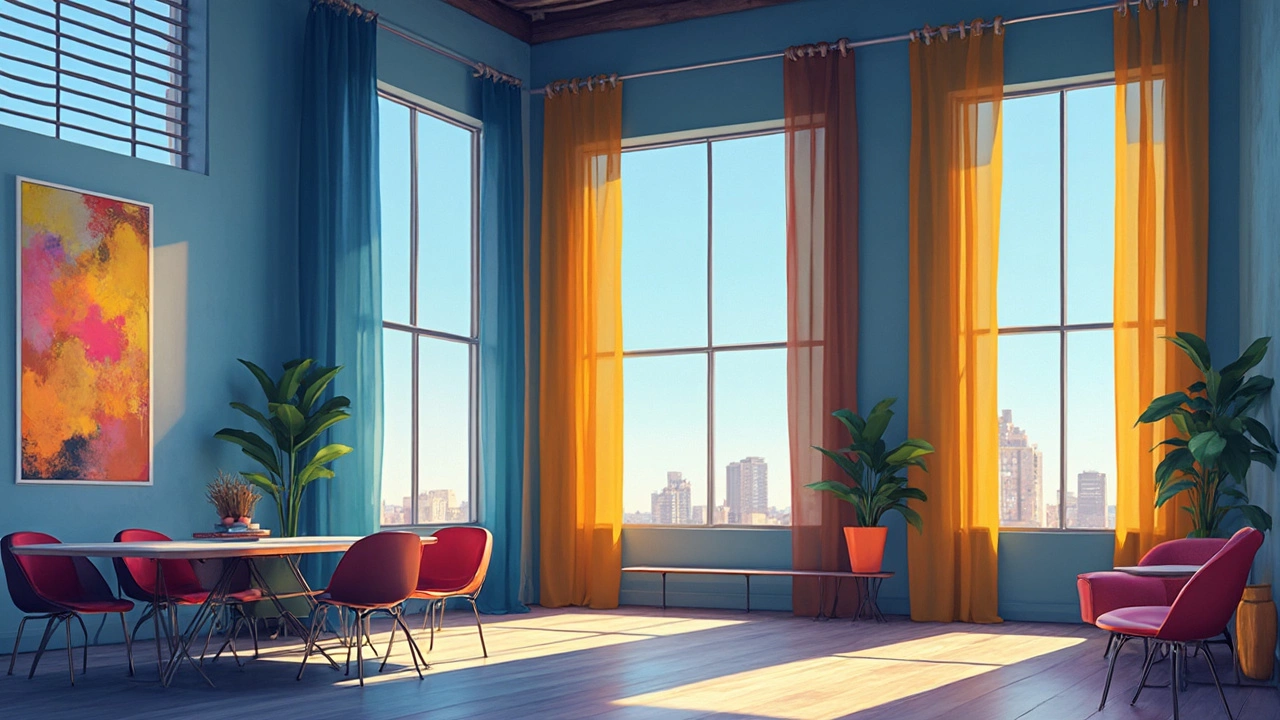How Far Down Should Curtains Hang?
 Mar, 20 2025
Mar, 20 2025
Figuring out how far down your curtains should hang isn't just about looks; it's about getting the room's vibe just right. The length of your curtains can really set the tone, whether you're going for something sleek and modern or cozy and traditional.
First off, let's talk about that popular 'floor grazing' style. If you're aiming for curtains that just kiss the floor, you're dealing with a timeless look. You'll want to measure from the curtain rod to the floor and maybe add an extra inch or so to make sure those curtains meet the floor exactly but don't drag. This style adds a clean, tailored touch to any room.
- Finding the Right Length
- Floor Grazing Styles
- Puddling Curtains
- Measuring Tips for Success
- Common Mistakes to Avoid
Finding the Right Length
When it comes to picking the perfect curtain length, several factors come into play. It's not just about style; it's also about how your curtain length is going to work with other elements in your room.
Consider the Room's Purpose
The room's function plays a huge role in deciding curtain length. In a formal dining room, you might want curtains that pool on the floor for a lush, elegant look. In a kid's room, though, floor-grazing or shorter curtains are practical—they're less likely to become a hazard.
Window and Ceiling Height
How high are your ceilings? And how big are your windows? These questions guide you on where to set up your curtain rods. For a more dramatic feel, especially in rooms with high ceilings, install rods closer to the ceiling and let those curtains drape down. This trick can make windows appear taller.
Design Preferences
Your personal taste shouldn't be ignored. If you want ultra-modern, think about curtains that barely skim the floor. For something more traditional, some folks go for that puddle effect, where the curtains are a bit longer and create a pooled effect on the floor.
| Style | Length Description |
|---|---|
| Modern | Just touches the floor or hangs slightly above |
| Traditional | Puddles onto the floor |
| Casual | Slightly above the floor |
Practical Tips
- Always measure more than once. Measure twice, hang once—it's a lifesaver.
- If you're unsure, start with longer curtains. You can always have them tailor-trimmed.
- Consider the material—heavy materials might need reinforcement at the top to prevent sagging.
These considerations will ensure your window treatments achieve both functionality and style, helping you nail the right vibe for each space.
Floor Grazing Styles
Alright, so you're thinking about floor-grazing curtains. This style works wonders for just about any room because it offers a neat and polished look. As the name suggests, the curtains should just skim the floor, which means getting your measurements right is crucial.
Why go for this style? Well, it's versatile. Whether you have a contemporary or traditional setup, this length complements just about any decor. Plus, it helps in making the ceilings look higher and the room more expansive, a nifty trick for small spaces.
How to Achieve the Perfect Length
- Start by measuring from the floor to just above your window frame or where you plan to install the curtain rod.
- Add an inch to account for the curtains settling slightly over time or if you desire that 'barely-there' touch to the floor.
- If possible, choose adjustable rods which give you some flexibility to tweak the height, ensuring a snug fit.
And don't worry about everyday activities causing them to swing too much—just make sure pets and kids aren't likely to pull at them, and you should be golden!
Quick Tips
- If you have a radiator or baseboard heater under your window, make sure the curtains don’t clash with them. Leave a slight gap for safety and style.
- Pick a sturdy fabric if your curtains are likely to touch the floor regularly to reduce wear and tear.
With curtain length in mind, always remember the vibe you want to create. Floor-grazing styles give you a mix of elegance and practicality, perfect for folks who want that touch of sophistication without the hassle of constant training and care.

Puddling Curtains
Ever seen curtains that pool on the floor and thought, "That looks super fancy"? That's what we're talking about with puddling curtains. This style is all about that extra fabric creating a puddle effect, making the room feel more luxurious and relaxed, like something out of a magazine.
Puddling curtains aren't just for looks, though — they offer great insulation by providing extra coverage, which can be handy for drafty windows. They're also fab at keeping out light, giving you that perfect Sunday morning sleep-in vibe.
How To Achieve the Perfect Puddle
Getting the right amount of puddle can be a bit of a balancing act. Too much and you'll trip over the stuff; too little and it just looks like a mistake.
- Just Touching the Floor: Add about 1 to 3 inches of extra curtain length. It's a subtle look, for a minimal puddle.
- Moderate Puddle: This style adds around 4 to 6 inches and creates a noticeable pile on the floor — great for adding a bit of drama.
- Opulent Puddle: Go big with 8 to 10 inches or more. It's bold and perfect if you're really looking to make a statement.
Real-world Tips
Before you go all in on the puddling style, think about how practical it is for your space. Got pets or kids that might tangle with those long curtains? Maybe keep it to a modest puddle if so. Additionally, it's worth noting that this style works best on high-quality, heavy fabrics like velvet or silk that drape well. Plus, they just feel classier!
Keep maintenance in mind, too. All that extra fabric can collect dust, so occasional cleaning or even a quick vacuum might be necessary to keep them looking fresh. A little effort keeps your curtains elegant and your allergies at bay!
Measuring Tips for Success
Getting the measurements right is the first step towards perfect curtain length. It might sound tedious, but trust me, nailing this part can make all the difference. Let's break down some tips that can truly help lift your curtain game.
Pick the Right Spot for the Rod
Before you even think about buying curtains, decide where you’ll be hanging the rod. Ideally, mount it about 4 to 6 inches above the window frame. This creates an illusion of a taller window, which is always a good thing.
Measure the Length
With the rod in place, measure from the top of the rod to the floor. If you're opting for floor grazing styles, add another couple of inches to ensure they fall just right. Avoid skimping on length—curtains that are too short can make windows look awkward.
Consider the Curtain Style
- Grazing: Just touching the floor. Perfect for bedrooms and living rooms where a clean line is desired.
- Puddling: Add 4-6 inches to create a dramatic effect. Good for more formal settings.
Avoid These Common Pitfalls
While measuring might seem straightforward, there are a few mistakes many people make. First, assuming the floor is level across the entire span of the window can lead to uneven hems. Check the level in a few places, just to be sure.
Another common mistake? Forgetting to account for shrinkage if you're using natural fabrics like cotton or linen. To stay on the safe side, wash and dry these fabrics before measuring and cutting.
By taking these steps, you ensure that once your curtains are up, they don't just fit—they look totally intentional and polished.

Common Mistakes to Avoid
Who would've thought hanging curtains could be tricky? Yet, many folks trip up over some common mistakes that can totally mess with the look of their rooms. Let's tackle these to ensure you get it right!
1. Hanging Curtains Too Low
One of the biggest snafus is placing the rod too close to the window frame. This can make the ceilings feel lower than they actually are. A great trick is to mount the rod closer to the ceiling, which creates the illusion of taller windows.
2. Choosing the Wrong Length
Picking a curtain length that’s too short or too long can disrupt the room's flow. Curtains should either graze the floor or have a bit of 'puddle' for elegance. As interior designer Sarah Richardson says,
"Curtains that float six inches off the floor is like wearing trousers that are too short for you."
3. Not Considering the Fullness
Another pitfall is not accounting for curtain 'fullness'. Ideally, when closed, your curtain should be about 2 to 2.5 times as wide as the window. This fullness adds a plush, luxurious feel, rather than a flat, skimpy appearance.
4. Ignoring the Fabric Weight
The weight of your curtain fabric can affect how it hangs. Lightweight fabrics will naturally billow, whereas heavier fabrics like velvet add more drama but require sturdy rods. The right balance is crucial for both appearance and practicality.
- Lightweight fabrics: Sheers, linens
- Heavyweight fabrics: Velvet, tapestry
5. Overlooking the Context
Ultimately, every window is different. Whether it's about blocking out light or just looking good, consider the function as well as the style. A thick, blackout curtain works great for a bedroom, while something sheer and breezy might suit a living room better.
Dodge these mistakes, and your interior design game is sure to get a major upgrade!